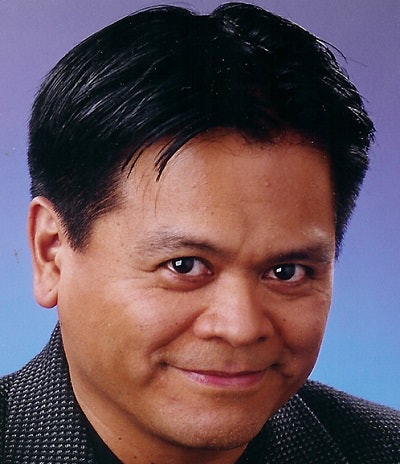The SAT folks took the easy way out on the so called “Adversity Score” proposal. After announcing the plan to come up with a simple tool to help evaluate admissions candidates, the College Board caved to criticism and dropped the idea.
In this analytical age, where data beats out humanity, maybe this is a thing that should be celebrated. Yes, we’re not just a number. We’re human. We’re living beings capable of growth.
Then again, if that were the case, let’s get rid of the SAT itself.
Of course, the SAT won’t do that. SATs are a number everyone agrees to love and hate. Easier just to rid ourselves of progressive places like Hampshire College.
 Emil Guillermo
Emil GuillermoBut an “Adversity Score”? Too many numbers.
People must have been afraid a new tool might help admissions folks see the obvious more clearly.
Or establish a new metric that might ultimately be too restrictive or revealing, or both.
Better to stick to the status quo and read the essay of every applicant.
That’s why on the face of it, an adversity number makes sense. You get an at a glance sense of an applicant. But one criticism was that the number didn’t factor in the income or education of the parents.
Would that have been such a hard adjustment really?
In my case, I went to the best all-academic/magnet public high school in San Francisco, Lowell High School. My learning environment score would likely have been a 90-100 out of 100.
But if I came from a not so great part of town, my home environment score wouldn’t have been so high. To answer critics of the adversity score, , add in a few missing factors like qualifying for free lunch; or my immigrant parents who never graduated from high school; my family’s status as lifelong renters with no assets; who were underemployed and lived on SSI payments.
What kind of more meaningful “home” number would I have with the enhancements—maybe a 40 would drop to a 20 or lower.
In any event, a quick glance would have let an admissions committee know immediately what I overcame. A 90 and a 20? And I still got As and Bs? That tells you something. And it says I’m not Lori Loughlin’s kid who would likely be close to 100 on both, and with a fake spot on the crew squad.
What I liked is that a number simplifies all the verbiage in an application that reads like a pr release. A bleary-eyed admissions officer on deadline with a stack of candidates could use a little help. The Adversity Score could have been the focusing tool needed.
But the College Board chickened out.
My enhanced version of the AS might have addressed the critics. And colleges can still adopt an ad hoc version of it on their own. Some 150 or so schools starting using the adversity score this year. More were to do it next year. No more.
Maybe after this experience we should all accept that college admissions is more art than science. More data won’t get you certainty, and certainty isn’t really the goal anyway. We’re building learning communities and there will be some good admits. And some bad. At the core of both sides of the process aren’t numbers but humans. And they tend to be unpredictable.
DIVERSITY, THY NAME IS CANADA?
I took a break from the humdrum of American life and escaped north to Canada, where they like Labour Day so much they gave it an extra vowel.
It was great for my mental health, like experiencing free health care just for visiting.
I just wanted to get away from the constant news suck that is the latest Trump blurt.
The president doesn’t realize that as the leader of the free world everything he says makes news. Truth or lie. You can’t ignore him. Because it may really be a lie that matters.
Canada turns out to be just the place to go to vacate from Trump. (Just avoid walking by the Trump Hotel in Vancouver).
I was less than three hours from Seattle when I hit the border and was greeted not by some Dudley Do-right type, but by a Canadian- South Asian border agent who let me through without problem.
It was a harbinger of the shot of diversity I’d experience during my time in Vancouver, British Columbia.
Turns out diversity is what Canada is all “aboot.”
The accents I heard ran the gamut. Chinese, Hong Kong, Tawain, Korean, Vietnamese, South Asian, Filipino, Malaysian, Sri Lankan. African. Latino. I heard all their voices. Saw all their faces. All of them Canadian.
Most of the efforts for diversity I saw were from the government. A mini-documentary on TV talked about the indigenous and how they were sent to schools and stripped of their culture and native lands. The short pieces just scratched the surface, but were intended to inform people of the past mistreatment. The indigenous were there first, and there’s a real awareness of that when I went to Vancouver.
During my stay, there was a Taiwanese street festival that featured games and culture. But all mixed. One booth in particular showcased African drumming. Another went intra-Asian, showing the connection between the Vietnamese experience and the Taiwanese.
The city was clean, safe, friendly. People were biking, walking, taking public transit. I found vegan food everywhere, even vegan poutine, Canadian comfort food involving hot gravy, fries and cheese curds. Ethnic food was everywhere. An Indian Chinese restaurant next to a Mexican restaurant, next to a Greek or Middle Eastern place. The city reflects the people and that diversity only y adds to the beauty of the natural environment around you. Not something to be fracked and exploited for profit. But something to protect. Vancouver’s just one city, but what a jewel nestled in a natural setting of ancient forests on mountains overlooking the ocean.
Canada definitely had an ethos that is becoming undone in America, where the president routinely underplays diversity and creates policy to discourage the poor and asylum seekers. Immigration? Rich people, well-connected only. Give us your brain surgeons only. Likely to be on public assistance? Not welcome.
Canada is far from perfect. Vancouver had the homeless in a massive tent city near the waterfront. At least it seemed more orderly than what I’ve seen in the U.S. And according to the news while I was here, there’s an opioid problem too.
But unlike America, where immigrants and people of color are under constant attack from the president, in Canada, I felt none of that.
The indigenous were respected and honored. Immigrants were embraced as part of the mainstream. Rich, poor, there was a great sense of unity. Not fear.
Things you just don’t see in America these days.
I’m sure the white supremacists are somewhere in Canada. But for the most part they seem to stay under their rock.
Canada I found was welcoming and inviting. And the dollar is strong. You get a dollar Canadian for .75 cents. Everything is on sale at a discount.
But not diversity. In Canada, it’s valued at a premium, and worth every penny.
It’s a lesson America should learn from its neighbor to the north.
Emil Guillermo is a journalist and commentator. You can follow him on Twittter @emilamok



















